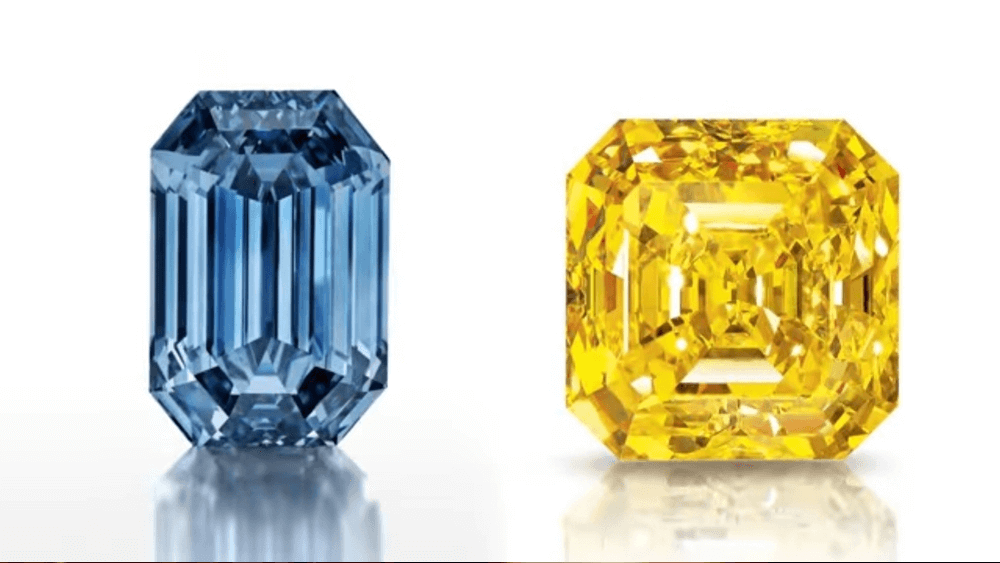The Negative Effects Of Fluorescence On Diamond Appearance

By Gary A.

Edited by Olivia H.
Published Jul 18, 2022
Edited on Dec 18, 2024
While diamond fluorescence may seem like a harmless feature, it can often diminish the overall clarity and brilliance, making it essential to carefully weigh its impact before making a choice.

Navigate This Guide:
- 7 Quick Tips for Examining Diamond Fluorescence in Engagement Rings
- Introduction
- What is Diamond Fluorescence
- The Color Spectrum of Fluorescence
- Grading the Glow: The GIA Fluorescence Scale
- How Fluorescence Improves Diamond Color
- Our Expert Take
- 10 FAQs
Before we dive deeper into the specifics, here are some practical tips to help guide your decision-making process:
7 Quick Tips for Examining Diamond Fluorescence in Engagement Rings
Understanding Fluorescence Impact on Color Fluorescence in a diamond can affect its appearance, especially in terms of color. When buying an engagement ring, it’s crucial to understand how fluorescence interacts with the diamond’s color.
- Tip 1: Observe the Diamond in Different Lighting Conditions: Fluorescence can become more or less visible under different lighting. View the diamond under natural sunlight, indoor lighting, and if possible, under a UV light source. This will help you see how the fluorescence affects the diamond’s color in various environments.
- Tip 2: Pay Attention to Fluorescence Intensity: Diamonds are graded for fluorescence intensity from None to Very Strong. Strong or very strong fluorescence can sometimes give the diamond a hazy or milky appearance, especially in high-color (D-F) diamonds. On the other hand, faint to medium fluorescence might not have a noticeable impact and can sometimes improve the color appearance of lower-grade color diamonds (G-J).
- Tip 3: Consider the Diamond’s Color Grade: The impact of fluorescence is more pronounced in colorless diamonds (grades D-F). In these diamonds, strong blue fluorescence can sometimes make them appear oily or hazy. In contrast, for near-colorless (G-J) or slightly tinted diamonds, blue fluorescence can make them appear whiter.
Assessing Fluorescence Aesthetics
Beyond the technical aspects, the aesthetics of fluorescence can be subjective and should be considered based on personal preference. We recommend avoiding Strong and Very Strong Fluorescence in diamonds.
- Tip 4: Evaluate the Visual Appeal: Examine if the fluorescence adds to or detracts from the beauty of the diamond to your eye. Some people find the glow of fluorescence unique and attractive, while others prefer a diamond without this characteristic.
- Tip 5: Check for Overall Transparency and Brilliance: Ensure that the diamond’s fluorescence does not impact its overall transparency and brilliance negatively. A fluorescent diamond should still exhibit the sparkle and fire that diamonds are known for, without any cloudiness.
Practical Considerations
Finally, some practical aspects can guide your decision when considering fluorescence in your diamond engagement ring.
- Tip 6: Factor in the Price Implications: Fluorescence can affect the price of a diamond. Diamonds with noticeable fluorescence are often priced lower than those without. This can be an opportunity to find a beautiful diamond at a more affordable price, provided the fluorescence doesn’t negatively impact its appearance.
- Tip 7: Consider Long-Term Satisfaction: Think about your long-term satisfaction with the diamond. If the fluorescence creates an effect that you find appealing and it aligns with your aesthetic preferences, it can be a unique and personal choice for your engagement ring.
Now that you’ve got these practical tips, use Jeweler AI below to find the perfect engagement ring that suits your style and budget:
Introduction
Odds are that, by now, you’ve done at least some of the required reading on the Four Cs of Diamonds. At the very least, you’re probably aware of the fact that a diamond’s quality is determined according to cut, color, clarity, and carat weight and that these categories represent the most pressing things for any shopper to consider before committing to a diamond.
Still, there’s a little more to it than that. Diamond fluorescence represents yet another important consideration to add to your radar as you begin your search for the perfect diamond.
Fluorescence can be a great thing for your diamond. It can also be a bad thing, and significantly lower the visual appeal and value of your diamond. Confused? Don’t panic – knowing the basics will ensure you don’t make any mistakes.
What is Diamond Fluorescence?
Some diamonds fluoresce, meaning that they glow under black light. This glow is typically blue, although the glow varies from faint to bright – and, in more severe cases, can be to the detriment of the diamond’s appearance.
Fluorescence is not just a phenomenon reserved for white shirts under the disco black lights – it’s also a pretty common occurrence in nature. Many minerals, from opal to fluorite itself, will glow under UV lights – diamond included.
The majority of diamonds glow blue under UV light – and not to the extent that the appearance of the diamond is impacted under usual lighting conditions or daylight. Other diamonds will fluoresce different colors, such as red or green, but this is very rare.
Some diamonds, however, are so fluorescent that they can appear cloudy under direct sunlight. Their value can be lowered alarmingly, particularly if they have a high-color grade.
Are All Diamonds Fluorescent?
No, it is thought that just under a third of diamonds mined from the earth fluoresce.
This is yet another thing that serves to demonstrate quite how unique and fascinating every diamond is. Around 70% of diamonds have no fluorescence at all, meaning that, in many cases, this subject doesn’t impact a shopper’s decision at all.
Still, it’s very important to know that fluorescence can exist in a diamond, and that it’s not always ‘no big deal’.
The Color Spectrum of Fluorescence
Very minor fluorescence won’t be noticeable to the naked eye, but strong fluorescence means that the diamond will glow bright blue under black light, and that it is likely to appear sort of ‘milky’ under normal lighting conditions.
It also means that its value could be up to 70% lower than it would be for a similar diamond with faint or no fluorescence since the diamond’s appearance is permanently affected by its fluorescence.
Grading the Glow: The GIA Fluorescence Scale
The GIA’s grades for fluorescence are: None, Faint, medium, Strong, and Very Strong.
While it is not talked about as much as the Four Cs, a diamond’s fluorescence is checked and recorded within its GIA report. Since it impacts a relatively small number of diamonds – and impacts the value of even fewer than that – the topic is not considered to be as pressing as other natural or human-made features.
Still, shoppers should be wary of any diamond that strays beyond the range of None, Faint or Medium. Strong and Very Strong Fluorescence is considered pretty undesirable, for a few key reasons…

Implications of Different Grades on the Fluorescence Diamond Scale
There’s no ‘ideal spot’ for fluorescence, as it can negatively impact diamonds with a higher color grade much more than it impacts diamonds with a slightly lower-color grade.
Still, that’s not to say you have to pass up a beautiful diamond simply because of its grade.
Faint Fluorescence in Diamond
This is normal and nothing to worry about. Faint fluorescence won’t cause any sort of a blue cast in your diamond, and it won’t make it appear cloudy, either.
Medium Fluorescence in Diamond
A medium grade should be avoided in diamonds with a very high-color grade, as any cloudiness can be more noticeable in these diamonds. In some diamonds, this level of fluorescence is thought to benefit the appearance of the stone.
Medium fluorescence still produces plenty of beautiful and wearable diamonds, but this category should be regarded as the upper limit and treated with caution as a result.
In diamonds with lower-color grades – particularly those in the lower end of the Near-Colorless category on the GIA’s Color Scale – some jewelers feel that a mild fluorescence can improve color, and counteract any slight tint the diamond might have.
Strong Blue Fluorescence in Diamond
This level of fluorescence will interfere with a diamond’s transparency. However, some rare diamonds can fluoresce blue without looking milky – and, for collectors, they hold a very unique sort of appeal.
When it comes to diamonds with cloudy/milky appearances, then strong fluorescence is a bad thing. Why? Because the trouble with a cloudy diamond is, unless you’re an expert who understands the different types of diamond inclusions, it won’t look like a real diamond at all. Even people who have never seen diamond ‘in the flesh’ before still know what they’re supposed to look like bright, vibrant, brilliant, and fiery and, put simply, more beautiful and dazzling than any other gemstone out there. A diamond that is so cloudy and dull that it appears to have had the life sucked out of it is going to appear to most people like a cheap imitation.
For instance, diamond simulants like cubic zirconia (CZ) can be cut and polished to look as much like diamond as possible, but they still can’t live up to expectations. CZ scratches easily and, over time, takes on a cloudy appearance – so you can imagine why a cloudy diamond fails to impress experts and non-experts alike.
Put simply, no one wants a cloudy diamond. While they’re pretty interesting things to look at and study under a microscope, they simply don’t live up to the expectations most of us hold for engagement rings and will fall short on one of the most important traits a diamond has: sparkle. You’re going to wind up paying far more than you should for a diamond that looks like it’s worth a fraction of its price tag.
As we mentioned above, however, a small number of diamonds have strong fluorescence, but no milkiness. In these instances, the strong fluorescence can help to make the diamond appear to have a better color than it really does when the diamond is exposed to the light. Some people (mainly collectors) enjoy tracking these diamonds down for their pretty unique properties and strong blue glow, which is visible when the diamond is exposed to UV light.
How Fluorescence Improves Diamond Color
In some cases, slight fluorescence can counteract the presence of a minor amount of visible color in a diamond.
The trouble for us is that looking for a diamond with the ‘right amount’ of fluorescence to improve its color is not an exact science. It is far easier and more cost-effective to look at diamonds with a Near-Colorless grade of G, H, I, or J. There are plenty of options that show no discernible color or fluorescence. For that reason, the overwhelming majority of buyers looking for a diamond for their engagement ring would prefer to stay safely within the lower grades (None, Faint, and Medium), ensuring little to no fluorescence and a clear, bright, sparkling diamond.
There are flaws worth investing in – inclusions and color that are not visible to the naked eye – but we can’t see the value in investing in a diamond that is flawed in this way. It’ll take you longer, and put you at more risk of a dud.
The better approach would be to look at diamonds with a slightly lower (though still eye clean) clarity grade, such as VS2 or SI1, or a slightly smaller diamond – or, perhaps, a diamond shape that’s good at concealing slight color (more on that below) so that you can afford to find a diamond that appears colorless.
While an interesting subject, fluorescence is generally seen as a negative trait in any diamond – and particularly among those looking to create an engagement ring – so don’t commit yourself to a potentially long and frustrating search for a diamond that has both color and fluorescence, but which appears colorless.
Fluorescence, Rarity, and Value
Fluorescence itself isn’t particularly rare, but some diamonds feature a very rare and beautiful form of fluorescence that gives them a distinctive blue color.
You musn’t get these diamonds mixed up with fancy blue color diamonds. These diamonds are made blue by the presence of trace amounts of the chemical boron, which ‘contaminated’ the diamond millions of years ago when it was still forming underground. These diamonds appear in varying shades of blue, from pale and icy to a deep, rich shade reminiscent of sapphire (though still offering the diamond’s unparalleled brilliance and fire). Their color is always visible,
Strong blue fluorescence is not always visible within the diamond – it ‘comes out’ when the diamond is exposed to UV light, such as a backlight. Under normal conditions, these diamonds will look pretty normal and unassuming.
Their popularity among certain collectors has made them marketable. The 5th generation diamond cutter Brian Gavin has turned strong blue fluorescence into a selling point. His collection ‘Blue’ comprises diamonds with strong fluorescence, but an AGS light performance grade of 0 (ideal).
Our Expert Take
Anywhere from ‘None’ to ‘Medium’ on the GIA Scale, although fluorescence – like any trait a diamond holds – will look different on every stone.
If you’re sticking firmly to the higher grades for color then, ideally, your diamond would have no fluorescence – but, as we said before, don’t let that deter you from an otherwise beautiful diamond. Provided you stick within this range, then the most important thing is what you think of the diamond – and, as we always say, whether or not it’s eye clean.
Chances are you don’t want to give your future bride a blue-tinted diamond. While they’re pretty cool to look at, they’ll never replace clear, sparkling diamonds as the ultimate token to present when you propose.
Still, you don’t need to beat yourself up if your heart is pulling you toward a diamond that has a certain amount of fluorescence. Weigh up the pros and (potential) cons, and let your instincts guide you the rest of the way.
10 FAQs
- Q: What is diamond fluorescence?
A: Diamond fluorescence is a phenomenon where diamonds emit a glow, typically blue when exposed to ultraviolet (UV) light. This is due to certain elements within the diamond’s structure. - Q: Does fluorescence affect a diamond’s value?
A: Yes, fluorescence can affect a diamond’s value. Strong or very strong fluorescence might lower the value of high-color (D-F) diamonds, while it may slightly increase or have a neutral effect on lower-color (I-J) diamonds. - Q: Can fluorescence make a diamond appear whiter?
A: Yes, in some cases. For near-colorless diamonds (G-J), medium to strong blue fluorescence can counterbalance yellowish hues, making them appear whiter. - Q: Is fluorescence in a diamond bad?
A: Not necessarily. It depends on the diamond’s color grade and the intensity of fluorescence. For some diamonds, it can be beneficial, while for others, particularly those with higher color grades, it might be seen as a disadvantage. - Q: How is diamond fluorescence graded?
A: The Gemological Institute of America (GIA) grades diamond fluorescence as None, Faint, Medium, Strong, or Very Strong, based on its visibility under UV light. - Q: What is the most common color of fluorescence in diamonds?
A: Blue is the most common color of fluorescence in diamonds, due to the presence of boron. - Q: Can you see fluorescence in normal lighting conditions?
A: Typically, fluorescence in diamonds is not visible under normal lighting conditions. It is usually observed under UV light, like that found in sunlight or black lights. - Q: Should I avoid buying a diamond with fluorescence?
A: It’s a matter of personal preference. If the fluorescence does not negatively impact the diamond’s appearance (like causing haziness) and you like how it looks, there’s no reason to avoid it. - Q: Can fluorescence be a sign of a diamond’s quality?
A: Fluorescence alone is not an indicator of a diamond’s overall quality. It should be considered along with other factors like cut, color, clarity, and carat weight. - Q: Do all diamonds exhibit fluorescence?
A: No, not all diamonds exhibit fluorescence. It’s estimated that around 25% to 35% of diamonds show some degree of fluorescence.
Sidestep fluorescent diamond concerns with Jeweler AI’s expert selection.
FOLLOW-UP GUIDE SERIES












